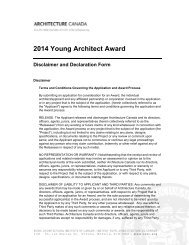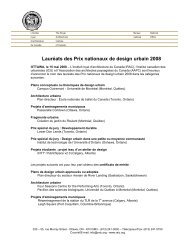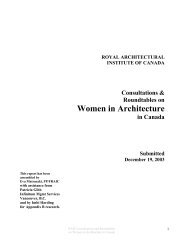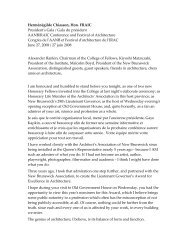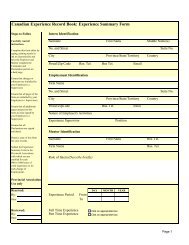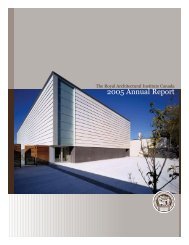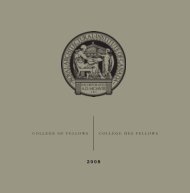RAIC 2006 Annual Report - Royal Architectural Institute of Canada
RAIC 2006 Annual Report - Royal Architectural Institute of Canada
RAIC 2006 Annual Report - Royal Architectural Institute of Canada
You also want an ePaper? Increase the reach of your titles
YUMPU automatically turns print PDFs into web optimized ePapers that Google loves.
All the above initiatives were pretty ambitious – and although they're not all complete, they are well<br />
underway. Then there was the additional agenda item – the most important initiative we have taken<br />
in decades – Challenge 2030.<br />
When I planned to be <strong>RAIC</strong> President in <strong>2006</strong>, I truly thought that sustainable<br />
design was "mainstream", "old hat" and that the <strong>RAIC</strong> was "done" with this<br />
agenda…and I guess I was wrong.<br />
At the Festival <strong>of</strong> Architecture in Edmonton in 2005 we heard from Ed Mazria<br />
FAIA, the founder <strong>of</strong> Architecture 2030. In November <strong>of</strong> <strong>2006</strong>, the <strong>RAIC</strong> adopted the 2030 Challenge,<br />
joining the American <strong>Institute</strong> <strong>of</strong> Architects, the <strong>Canada</strong> and the US Green Building Councils, the US<br />
Conference <strong>of</strong> Mayors, and American Society <strong>of</strong> Heating, Refrigerating and Air-Conditioning Engineers,<br />
supporting the urgent mandate for a carbon neutral built-environment by 2030.<br />
The 2030 Challenge calls for all new buildings and major renovations to reduce their fossil-fuel<br />
greenhouse gas-emitting energy consumption by 50 per cent immediately, increasing this reduction<br />
to 60 per cent in 2010, 70 per cent in 2015, 80 per cent in 2020, 90 per cent in 2025, and finally, that<br />
all new buildings be carbon neutral by 2030.<br />
That would mean that by 2030 the construction and operation <strong>of</strong> buildings will no longer require the<br />
consumption <strong>of</strong> fossil fuel energy or emit greenhouse gases.<br />
The <strong>Royal</strong> <strong>Architectural</strong> <strong>Institute</strong> <strong>of</strong> <strong>Canada</strong> <strong>2006</strong> <strong>Annual</strong> <strong>Report</strong><br />
The <strong>RAIC</strong> will now challenge and empower all its members,<br />
as well as its partners across <strong>Canada</strong>, including the<br />
Council <strong>of</strong> Canadian University Schools <strong>of</strong> Architecture, the<br />
Canadian <strong>Architectural</strong> Certification Board and others, to<br />
join in this challenge.<br />
Sustainable buildings are no longer optional. We join the<br />
CaGBC in setting ambitious goals.<br />
By 2012, Architects will design 100,000 new and renovated<br />
buildings across the country, using 50 per cent less energy<br />
than today, while creating healthy and delightful places for<br />
people. Currently there is about $30-$40 billion worth <strong>of</strong><br />
work "on the boards" in Canadian <strong>of</strong>fices. Once these buildings<br />
are designed and constructed, their carbon footprint is<br />
Operations Centre: Gulf Islands National Park Reserve<br />
(LEED <strong>Canada</strong> Platinum) | Larry McFarland Architects Ltd. | photo: Derek Leper<br />
set for 100 years. We can each do better. If every single building we design or renovate, reduces<br />
greenhouses gases by as little as 50 per cent, we can make a very big difference.<br />
Architects know that buildings can be designed to operate with far less energy than today's average<br />
– at little or no additional cost. This can be accomplished through proper siting, building form, glass<br />
properties and window location, material selection and by incorporating natural heating, cooling and<br />
ventilation and day-lighting strategies.<br />
We will challenge government to consider tax incentives. Imagine if all buildings designed to 50 per<br />
cent less energy than the Model National Energy Code <strong>of</strong> <strong>Canada</strong> for Buildings received full GST<br />
rebates. That would get results very quickly, especially in this day <strong>of</strong> P3 and lease-financed public<br />
and private buildings.<br />
President's <strong>Report</strong> 2



